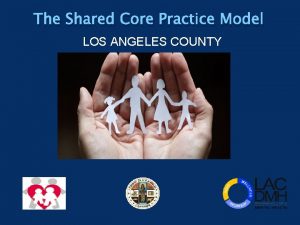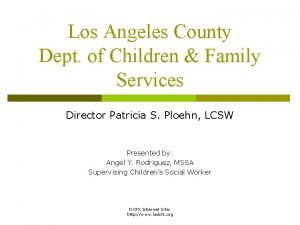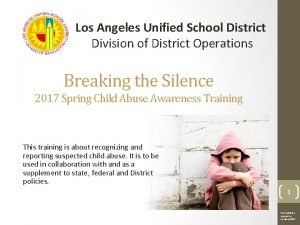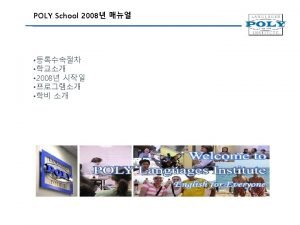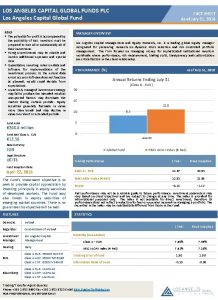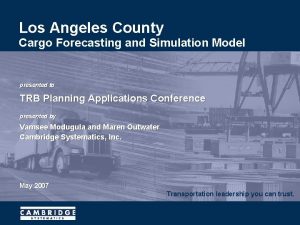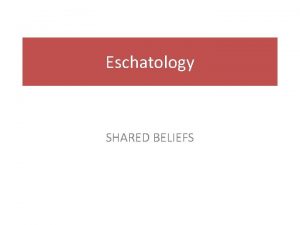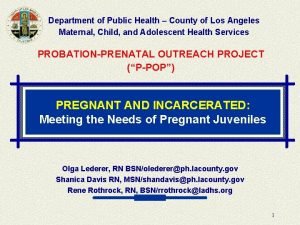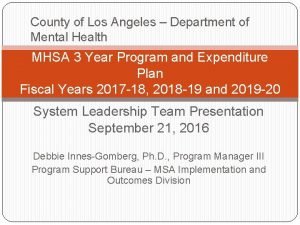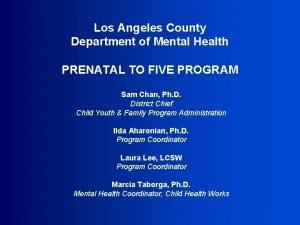The Shared Core Practice Model LOS ANGELES COUNTY
































- Slides: 32

The Shared Core Practice Model LOS ANGELES COUNTY

Learning Objectives • To learn about the Katie A. Settlement Agreement and its impact on the Child Welfare and Mental Health systems • To appreciate the Shared Core Practice Model and the practice elements • To review California Partners for Permanency (CAPP) and the 23 Practice Behaviors that support the Shared Core Practice Model • To expand our knowledge of the Strengths Based Approach to practice while assuring child safety

SCPM: A Common Framework LA County DMH, DCFS, & PROBATION • Adopting a Common Practice Model - Working towards a Common Vision - Sharing a Common Language • Transforming our Approach - Promoting Best Practice Standards - Improving Outcomes for Children and Families

Katie A. et al. vs Bonta Lawsuit • Class action lawsuit filed on behalf of 5 plaintiff foster children. • Sought to improve the provision of mental health and supportive services for children and youth in foster care. • Challenged the State and County agencies for neglecting their duties to provide necessary and legally mandated mental health care services to foster children.

Katie A. Settlement Agreement • Children and families will receive mental health services in a timely manner • Child Welfare and Mental Health Systems will change the standard of practice • Children and families will receive care and services to prevent removal, and maintain safety, permanence and stability

California Partners for Permanency (CAPP) Practice Model • Focus is to reduce the number of children in long-term foster care • 23 Practice Behaviors describe actions for staff to engage in when interacting with children, families and the community • New way of working with children, families and their teams, while keeping children safe

Shared Core Practice Model Tracking & Adapting Engaging Teaming STRENGTHS NEEDS PRACTICE & CHILD SAFETY Planning & Intervention Long Term View Assessment & Understanding Cultural Humility Trauma Responsive

Quality Service Review (QSR) • Used to assess and evaluate current practice • Uses a combination of record review, interviews and observation • Overall Practice and Overall Status must be 85% • The following 3 Practice indicators must score 70% - Engagement - Teamwork - Assessment

What Do You Value…

Shared Core Practice Model Values • Children/youth are first and foremost protected and safe • Family-Centered Practice: Respecting the family’s voice and choice; developing trusting, working relationships • Strength based assessments that identify underlying needs with families

Shared Core Practice Model Values • Individualized plans and services based on underlying needs • Teaming and collaboration with family and community partners • Cultural Humility & approaching all interactions with respect

CPM in Action!

Shared Core Practice Model Tracking & Adapting Engaging Teaming STRENGTHS NEEDS PRACTICE & CHILD SAFETY Planning & Intervention Long Term View Assessment & Understanding Cultural Humility Trauma Responsive

Engaging SCPM ELEMENT PRACTICE BEHAVIORS • Approaches all interactions with openness through listening and using understandable language. Engaging: • Consistently models honest and respectful communication. Creating trustful working relationships with a child and their family • Explores family relationships and natural circles of support. • Identifies safety issues and how they can be addressed. • Explores with children worries, wishes and with whom they feel safe and want to live with.

Teaming SCPM ELEMENT PRACTICE BEHAVIORS • Establishes and continuously brings together, and supports the child and family’s team. Teaming: Building and strengthening the child and family’s support system • Facilitates and coordinates sharing of important information among all parties. • Creates environment for open and honest communication among all parties. • Follows through and admits bias, missteps and mistakes.

Child and Family Teaming Benefits of the CFT Process • Empowers Family and Youth to use their Voice and Choice • Encourages the Family to articulate their Family Goal and Vision • Focuses on the Family Story to identify Strengths and Underlying Needs • Helps the Family form their Team of Natural and Informal Supports

Engagement/Teaming Activity Listening is Key to Teaming

Assessment & Understanding SCPM ELEMENT PRACTICE BEHAVIORS • Acknowledges and validates Assessment & Understanding: Collaborating with a family’s team to obtain information about their strengths and underlying needs feelings of grief, loss and trauma. Listens to the family’s story and helps explore history and impact. • Shows understanding that normal is different for everyone. • Individualizes underlying needs and solutions. • Uses cultural humility when assessing for safety, well-being and understanding of underlying needs.


Functional Strengths • Skills you use everyday • Every individual & family has strengths • Family culture & story is a source of identifying strengths • The child and family’s strengths can be mobilized to meet the child’s needs

At My BEST…

What Are Underlying Needs? affection protection safety security belonging self-esteem confidence acceptance connections basic needs

Planning & Intervening SCPM ELEMENT PRACTICE BEHAVIORS § Planning & Intervening: Tailors Plans to build on strengths to meet individual needs for each child and family § § Facilitates appropriate supports and services. Explores with the team how programs can assist the family. Shared commitment and accountability: identifies roles and responsibilities and timeframes for accomplishing goals.

Tracking and Adapting SCPM ELEMENT Tracking & Adapting: Evaluates the effectiveness of the plan; adapting to challenges; celebrating success and organizing aftercare support PRACTICE BEHAVIORS • Facilitates continuous dialogue with the family/youth and their team about how supports and services are working. • Make adjustments based on the child and family team. • Promotes the importance of the family and youth’s circle of support team even beyond the time of agency involvement.

Let’s Practice…

Shared Core Practice Model Tracking & Adapting Engaging Teaming STRENGTHS NEEDS PRACTICE & CHILD SAFETY Planning & Intervention Long Term View Assessment & Understanding Cultural Humility Trauma Responsive

Long-Term View SCPM ELEMENT PRACTICE BEHAVIOR • In all interactions affirms Long Term View: The degree to which there are stated, shared and understood goals of safety, well-being and permanency outcomes, as well as, functional life goals for the child and family unique strengths, life experiences, and selfidentified goals of family. • Honors the role of culture and community connections in the exploration of issues, options and solutions. • Identifies needed supports in the long term planning.

Cultural Humility SCPM ELEMENT PRACTICE BEHAVIORS • Uses culturally sensitive Cultural Humility: Seeks to explore and embrace diversity; listens for and is open to differences in experience, perception, values, beliefs and traditions; supports exploration of how one’s bias and assumptions may impact interactions services to address child safety, well being and family needs. • Assesses and arranges culturally appropriate activities and services in the most natural environment. • Explores cultural practices and traditions that can assist with grief, loss and trauma.

Trauma Responsive SCPM ELEMENT Trauma Responsive: Recognizes that interventions can cause traumatization & re-traumatization. Utilizes a comprehensive assessment to guide practice. Explore how one’s own traumatic experience may impact interactions and practice PRACTICE BEHAVIORS • Acknowledges and validates feelings of grief, loss and trauma. • Explores history and experiences and how this may be impacting one’s current life situation and underlying needs. • Connects and advocates for a broad array of culturally sensitive services to assist with healing.

Moving forward: How can SCPM help? Tracking & Adapting Engaging Teaming STRENGTHS NEEDS PRACTICE & CHILD SAFETY Planning & Intervention Long Term View Assessment & Understanding Cultural Humility Trauma Responsive

SELF CARE REQUIRED “Tips for a Better Life”

Thank You! • For all your hard work! • For your dedication to helping children & families thrive in their communities!
 Sketch
Sketch Lenguas de hombres
Lenguas de hombres Different classes of submarines
Different classes of submarines Prochinetice
Prochinetice Los angeles harbor college admissions
Los angeles harbor college admissions Children and family services los angeles
Children and family services los angeles Rdox los angeles
Rdox los angeles Doctora roselyn valerin
Doctora roselyn valerin Upa los angeles
Upa los angeles Right side up agency
Right side up agency Los angeles schools
Los angeles schools Los angeles position
Los angeles position Los angeles schools
Los angeles schools Los angeles oesophagitis classification
Los angeles oesophagitis classification Angie rupert
Angie rupert Los angeles oesophagitis classification
Los angeles oesophagitis classification La county cottage food
La county cottage food City of los angeles department of recreation and parks
City of los angeles department of recreation and parks Savannah ga to los angeles ca
Savannah ga to los angeles ca Redlining los angeles
Redlining los angeles Clemens hong
Clemens hong Usa rozloha
Usa rozloha Poly language school
Poly language school Distancia entre san francisco y napa valley
Distancia entre san francisco y napa valley Lacc math sequence
Lacc math sequence Parroquia san estanislao de kostka
Parroquia san estanislao de kostka Los angeles obyvatelstvo
Los angeles obyvatelstvo Cccco guided pathways
Cccco guided pathways Residencia medinaceli getafe
Residencia medinaceli getafe Fatih uckun
Fatih uckun Digital billboards los angeles
Digital billboards los angeles Maria de los angeles fortis barrera
Maria de los angeles fortis barrera Csc los angeles canvas
Csc los angeles canvas
